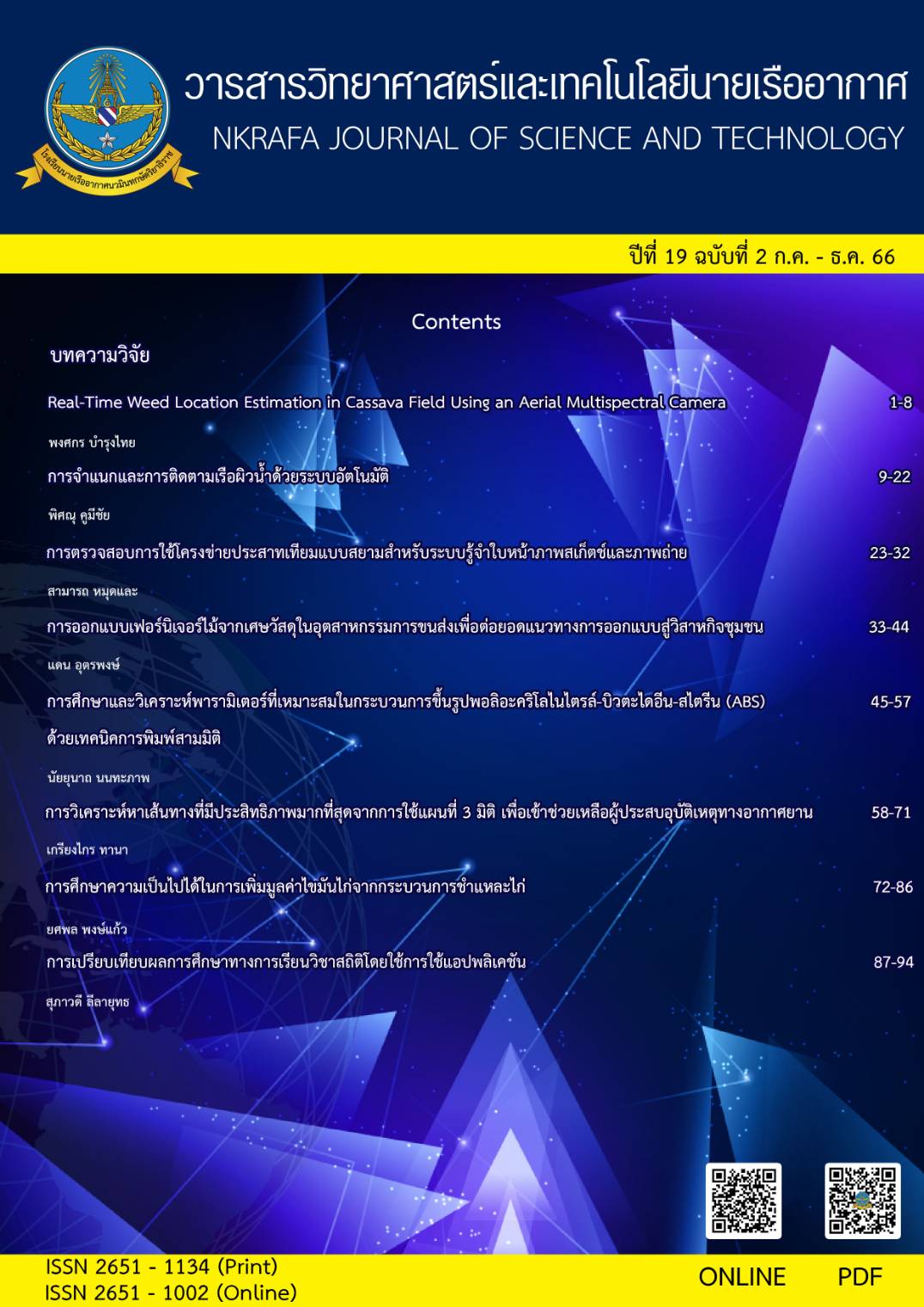Real-Time Weed Location Estimation in Cassava Field Using an Aerial Multispectral Camera
Main Article Content
Abstract
This research presents a real-time weed location estimation system for precision agriculture in cassava planting. The widely employed vegetation index known as the normalized difference vegetation index (NDVI) was applied to identify and estimate the locations of the weed. The multispectral camera mounted on an unmanned aerial vehicle (UAV) with nadir orientation was used to capture the field images. The NDVI values were calculated in real-time using an onboard microcomputer and streamed weed locations in latitude/longitude format to the ground control station. The UAV with the attached camera was controlled to follow a predefined flight path using user-specified coordinates based on the configuration of the planting area. The flight altitude was set at 10 m above ground level. Experimental flight tests were conducted over a cassava field covering an approximate area of 2,500 m2. The results demonstrated that detected weed locations exhibited errors within the precision bounds of the GPS system. In the future, a spraying system could be implemented on the UAV to eliminate weeds and perform other planting operations.
Article Details

This work is licensed under a Creative Commons Attribution-NonCommercial-NoDerivatives 4.0 International License.
- Content and information in articles published in NKRAFA Journal of Science and Technology are comment and responsibility of authors of articles directly. Journal editorial do no need to agree or share any responsibility.
- NKRAFA Journal of Science and Technology Articles holds the copyright of the content, pictures, images etc. which published in it. If any person or agency require to reuse all or some part of articles, the permission must be obtained from the NKRAFA Journal of Science and Technology.
References
Tirawatsakul, M. (1983). Weed control in cassava. In: Cassava Monograph No.7, Department of Agriculture, Bangkok, Thailand. 163 p. (in Thai)
Nebiker, S., Annen, A., Scherrer, M. and Oesch, D., "A Light-Weight Multispectral Sensor for Micro UAV-Opportunities for very High Resolution Airborne Remote Sensing," The International Archives of the Photogrammetry, Remote Sensing and Spatial Information Sciences, 37, 1193-2000 (2008).
Martin D.B. et al., (2010). UAV-based environmental monitoring using multi-spectral imaging, Proc. SPIE 7668, Airborne Intelligence, Surveillance, Reconnaissance (ISR) Systems and Applications, Vol. 7, pp. 766811. Orlando, Florida, United States: SPIE
Y. A. Pederi and H. S. Cheporniuk. (2015). Unmanned aerial vehicles and new technological methods of monitoring and crop protection in precision agriculture. IEEE International Conference Actual Problems of Unmanned Aerial Vehicles Developments (APUAVD) (298–301). Kyiv, Ukraine: IEEE
Randal W. Beard and Timothy W. McLain. (2012). Small Unmanned Aircraft: Theory and Practice , Second Edition. New Jersey: Princeton University Press.
Louargant, M., Jones, G., Faroux, R., Paoli, J.-N., Maillot, T., Gée, C., & Villette, S. (2018). Unsupervised Classification Algorithm for Early Weed Detection in Row-Crops by Combining Spatial and Spectral Information. Remote Sensing, 10(5): 761
Sunil G C, Yu Zhang, Cengiz Koparan, Mohammed Raju Ahmed, Kirk Howatt, Xin Sun. (2022). Weed and crop species classification using computer vision and deep learning technologies in greenhouse conditions, Journal of Agriculture and Food Research, Volume 9: 1-15.
Corceiro, A., Alibabaei, K., Assunção, E., Gaspar, P. D., & Pereira, N. (2023). Methods for Detecting and Classifying Weeds, Diseases and Fruits Using AI to Improve the Sustainability of Agricultural Crops: A Review. Processes, 11(4): 1-40.


